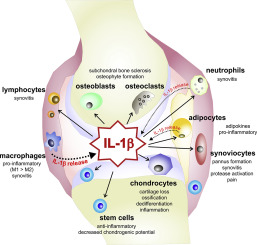当前位置:
X-MOL 学术
›
Cell. Signal.
›
论文详情
Our official English website, www.x-mol.net, welcomes your
feedback! (Note: you will need to create a separate account there.)
Interleukin-1β signaling in osteoarthritis - chondrocytes in focus.
Cellular Signalling ( IF 4.4 ) Pub Date : 2018-10-09 , DOI: 10.1016/j.cellsig.2018.10.005 Zsuzsa Jenei-Lanzl 1 , Andrea Meurer 1 , Frank Zaucke 1
Cellular Signalling ( IF 4.4 ) Pub Date : 2018-10-09 , DOI: 10.1016/j.cellsig.2018.10.005 Zsuzsa Jenei-Lanzl 1 , Andrea Meurer 1 , Frank Zaucke 1
Affiliation

|
Osteoarthritis (OA) can be regarded as a chronic, painful and degenerative disease that affects all tissues of a joint and one of the major endpoints being loss of articular cartilage. In most cases, OA is associated with a variable degree of synovial inflammation. A variety of different cell types including chondrocytes, synovial fibroblasts, adipocytes, osteoblasts and osteoclasts as well as stem and immune cells are involved in catabolic and inflammatory processes but also in attempts to counteract the cartilage loss. At the molecular level, these changes are regulated by a complex network of proteolytic enzymes, chemokines and cytokines (for review: [1]). Here, interleukin-1 signaling (IL-1) plays a central role and its effects on the different cell types involved in OA are discussed in this review with a special focus on the chondrocyte.
中文翻译:

骨关节炎中的白细胞介素-1β信号转导-软骨细胞成为焦点。
骨关节炎(OA)可以被视为一种慢性,疼痛和退化性疾病,会影响关节的所有组织,而主要终点之一就是关节软骨的丧失。在大多数情况下,OA与不同程度的滑膜炎症有关。各种不同的细胞类型,包括软骨细胞,滑膜成纤维细胞,脂肪细胞,成骨细胞和破骨细胞,以及干细胞和免疫细胞,都参与了分解代谢和炎症过程,但也试图抵消软骨的损失。在分子水平上,这些变化是由蛋白水解酶,趋化因子和细胞因子的复杂网络调节的(综述:[1])。在这里,白介素-1信号传导(IL-1)发挥着核心作用,本篇文章特别讨论了软骨细胞对OA中涉及的不同细胞类型的影响。
更新日期:2018-10-09
中文翻译:

骨关节炎中的白细胞介素-1β信号转导-软骨细胞成为焦点。
骨关节炎(OA)可以被视为一种慢性,疼痛和退化性疾病,会影响关节的所有组织,而主要终点之一就是关节软骨的丧失。在大多数情况下,OA与不同程度的滑膜炎症有关。各种不同的细胞类型,包括软骨细胞,滑膜成纤维细胞,脂肪细胞,成骨细胞和破骨细胞,以及干细胞和免疫细胞,都参与了分解代谢和炎症过程,但也试图抵消软骨的损失。在分子水平上,这些变化是由蛋白水解酶,趋化因子和细胞因子的复杂网络调节的(综述:[1])。在这里,白介素-1信号传导(IL-1)发挥着核心作用,本篇文章特别讨论了软骨细胞对OA中涉及的不同细胞类型的影响。











































 京公网安备 11010802027423号
京公网安备 11010802027423号